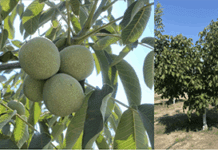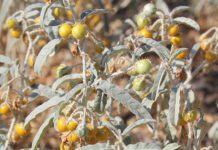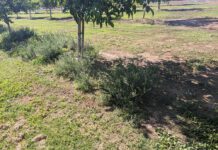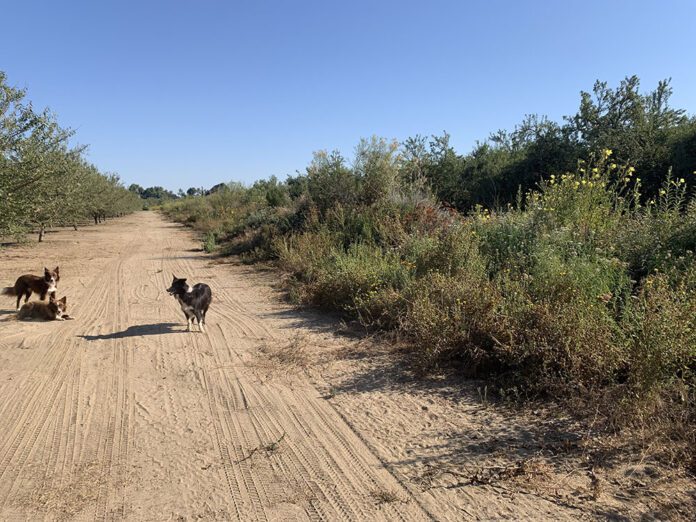
Listen to the audio version of this article. (Generated by A.I.)
A University of California study has shown established hedgerows can be an effective weed suppression tool in tree nut orchards.
Hedgerows are dense vegetation planted in a linear design, bordering an orchard or field. Hedgerows mainly consist of woody perennial plants with varying sizes. Grasses, shrubs or small trees can all be used for a hedgerow. Native plants adapted to the soil and environmental conditions at the site are the most likely to thrive.
Rachael Long, UCCE farm advisor emeritus in Yolo County, began the hedgerow study in 2015. The study, which covered 20 farm sites in three counties, was initiated to determine whether hedgerows of native California plants growing on orchard borders reduced weed numbers in orchards.
The study, published earlier this year, showed that in California’s Central Valley, mature hedgerows growing on orchard borders reduced field edge weed numbers by 66%, reduced weed species richness by 60% and weed cover by 74%. Long said in orchards, established hedgerows along the margins also reduced weed intrusion into the adjacent orchards several tree rows in.
Weed abundance and species richness were assessed during the summer and winter.
Full-grown hedgerows shaded out and outcompeted most weed species. They also slowed movement of weed seeds into the orchard.
“It was not a surprise. Once the native plants are established, they can outcompete the weeds,” Long said. She also noted in the study that weed seed predation by birds and other wildlife using the hedgerow as cover also helped suppress weeds in the borders.
Problematic weeds like fleabane, Johnsongrass, Italian ryegrass and field bindweed were lower in orchard field borders with hedgerows than conventionally managed edges.
Results of the study showed that reduced weed control practices with hedgerows led to lower weed management costs compared to conventional borders. Across all test sites, the average yearly cost for weed control in established hedgerows was 80% less than for conventional field borders. Density and cover of native plants yield greater weed suppression, Long said, helping reduce need for herbicides and other weed control practices.
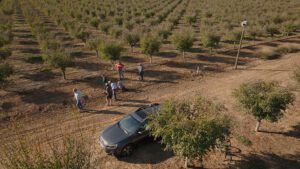
Hedgerow Establishment
Hedgerow site evaluation and preparation are important in plant establishment.
“You really have to know your soils and the environment where the hedgerow will be planted. Choose plants that are adapted to the soils,” Long advised.
Low spots where water pools should be avoided as California native plants generally don’t tolerate wet conditions. Alkaline soils or a high water table will require selection of tolerant plants.
Hedgerow site preparation will give the plants a better start. Long said clearing the site of weeds and laying a 2- to 3-foot-wide strip of wood chips at the site will allow the hedgerow to gain a head start over resident weeds. If a hardpan is present, it will need to be broken up before planting.
A UC Davis report suggests solarization of the planting site or chemical control of existing weeds before planting. The optimum window for planting hedgerows is mid-September through October to allow for plants to become established before the summer heat the following year.
Hedgerows of native plants will need weekly irrigation for the first three years after planting, depending on soil type and climate. Beyond that, Long said hedgerows should not require supplemental water. Long said the most common irrigation strategy after planting is to lay a drip line on top of the mulch layer with emitters matching the plant placings. She said the mulch layer helps hold moisture. Irrigation may be necessary once or twice a week during the summer and fall for the first year. By the third summer, Long said the drought-tolerant plants will need minimal or no irrigation.
The perception that hedgerows might harbor vertebrate pests is not true, Long said. The 15- to 20-foot-wide hedgerow strip is too small to play a large role in rodent habitat. Compared with fields or orchards that do not have hedgerows, the rodent populations were similar. The study did not find any food safety issues associated with hedgerows’ attractiveness to wildlife.
Long said she does not advise planting hedgerows while also establishing a new orchard. Both are long-term investments with different management practices and goals.
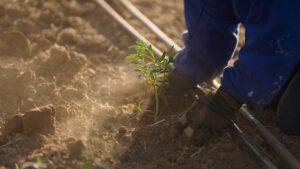
Pollinator Habitat is a Perk
The same goes for insect pests. Miles Dakin, co-director of agriculture programs for Pollinator Partnership, said there is a net positive benefit with hedgerows as they attract predatory insects that are beneficial in orchards, parasitizing pest insects.
There is also evidence that the native pollinators attracted to the flowering hedgerow plants push pollination by managed bees in orchards. Hedgerows provide twig and cavity nesting sites for natives.
Hedgerows can also be used to mitigate pesticide drift.
He stressed the importance of using native plants as they present fewer management issues. Oleander and invasive plants in hedgerows are not advised.
Dakin said there is a definite trend in agriculture toward adoption of hedgerow plantings. Funding for hedgerow projects in production agriculture by the Natural Resources Conservation Service, CDFA and Blue Diamond Growers over the past five years has accelerated planting. Dakin said in one year alone, in one program funded by CDFA’s Pollinator Habitat Program, 80,000 linear feet of hedgerows were planted in California.
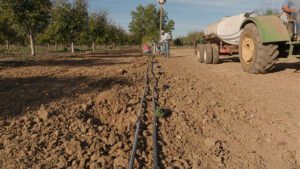
Funding Incentives
Funding for hedgerow plantings is available from the USDA’s Environmental Quality Incentives Program as well as CDFA’s Healthy Soils Program and Pollinator Habitat Program. Western Sustainable Agriculture Research and Education also provides assistance.
Long recommended working with one of the several nurseries in the state that propagate and sell native plants when considering a hedgerow project. Most commonly used plants include California buckwheat, California lilac, California coffeeberry, Cleveland sage, coyote brush, western redbud and toyon. Native plant nurseries can offer advice on which plants will do best in different areas of the state. Cornflower Farms in Elk Grove, Calif., Floral Native Nursery in Chico and Hedgerow Farms are sources for plants and recommendations on spacing and care.

Cecilia Parsons | Associate Editor
Cecilia Parsons has lived in the Central Valley community of Ducor since 1976, covering agriculture for numerous agricultural publications over the years. She has found and nurtured many wonderful and helpful contacts in the ag community, including the UCCE advisors, allowing for news coverage that focuses on the basics of food production.
She is always on the search for new ag topics that can help growers and processors in the San Joaquin Valley improve their bottom line.
In her free time, Cecilia rides her horse, Holly in ranch versatility shows and raises registered Shetland sheep which she exhibits at county and state fairs during the summer.




